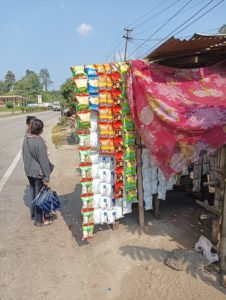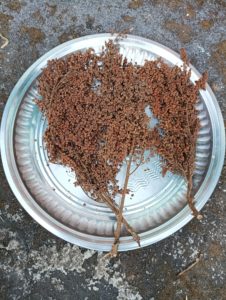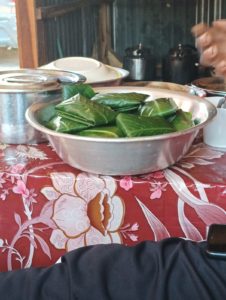Dr. Firdaus Samad and Arindam Biswas call attention to the changing food habits in the state, and underscore the importance of consuming traditional local foods as the road ahead for desired nutritional outcomes.
 The prevalence of stunted, wasted, and obese children has risen in Meghalaya, while the adult population is increasingly suffering from hypertension, diabetes, and obesity-related disorders. These health issues are primarily attributed to poor nutritional habits shaped by the local food environment. Four key factors constitute this environment: the availability of food in local markets, prices of those food items, types of vendors (such as small shops, supermarkets, and street food vendors), and marketing practices. Together, these significantly influence dietary choices. While addressing the marketing of unhealthy foods and regulating food vendors may require multi-sectoral collaboration and substantial resources, enhancing the availability of local traditional foods can directly impact nutrition. Traditional foods typically offer higher nutritional content compared to marketed items and are often more affordable, making them economically accessible to communities.
The prevalence of stunted, wasted, and obese children has risen in Meghalaya, while the adult population is increasingly suffering from hypertension, diabetes, and obesity-related disorders. These health issues are primarily attributed to poor nutritional habits shaped by the local food environment. Four key factors constitute this environment: the availability of food in local markets, prices of those food items, types of vendors (such as small shops, supermarkets, and street food vendors), and marketing practices. Together, these significantly influence dietary choices. While addressing the marketing of unhealthy foods and regulating food vendors may require multi-sectoral collaboration and substantial resources, enhancing the availability of local traditional foods can directly impact nutrition. Traditional foods typically offer higher nutritional content compared to marketed items and are often more affordable, making them economically accessible to communities.
Changing Food Environment
 Meghalaya’s food environment is changing. The shift away from foraging has led individuals to rely heavily on food items available in local markets, making them increasingly vulnerable to dietary changes. The types of vegetables, pulses, fruits, and grains marketed directly influence consumption patterns. This creates a vicious cycle where local farmers prioritise growing marketable crops instead of traditional ones. The focus on commercially viable produce is diminishing the cultivation of traditional foods, resulting in their slow disappearance from local diets.The price of marketed food fluctuates, often becoming more expensive. When that happens, these foods become economically inaccessible to many, leading to reduced intake of nutrient-rich options or complete avoidance. The rise of ultra-processed foods (UPFs) exacerbates this issue, contributing to an unhealthy food environment. In India, diets are transitioning from processed to ultra-processed foods due to preservatives used in packaging and the addition of artificial ingredients. UPFs are calorie-dense and nutritionally poor; they are laden with salt, sugar, and fat but lack essential micronutrients like vitamins and minerals crucial for body function. Typical UPFs include various chips, mixtures, street fast food items, ready-to-eat meals, sugary drinks, packaged beverages high in sugar and coloring agents, and
Meghalaya’s food environment is changing. The shift away from foraging has led individuals to rely heavily on food items available in local markets, making them increasingly vulnerable to dietary changes. The types of vegetables, pulses, fruits, and grains marketed directly influence consumption patterns. This creates a vicious cycle where local farmers prioritise growing marketable crops instead of traditional ones. The focus on commercially viable produce is diminishing the cultivation of traditional foods, resulting in their slow disappearance from local diets.The price of marketed food fluctuates, often becoming more expensive. When that happens, these foods become economically inaccessible to many, leading to reduced intake of nutrient-rich options or complete avoidance. The rise of ultra-processed foods (UPFs) exacerbates this issue, contributing to an unhealthy food environment. In India, diets are transitioning from processed to ultra-processed foods due to preservatives used in packaging and the addition of artificial ingredients. UPFs are calorie-dense and nutritionally poor; they are laden with salt, sugar, and fat but lack essential micronutrients like vitamins and minerals crucial for body function. Typical UPFs include various chips, mixtures, street fast food items, ready-to-eat meals, sugary drinks, packaged beverages high in sugar and coloring agents, and  various types of biscuits and cookies. Several studies have highlighted the link between UPFs and major health issues like hypertension, obesity, diabetes, and cancer. Consequently, the prevalence of UPFs in the food environment leads to increased health issues among nutritionally poor populations. As traditional foods recede from Meghalaya’s dietary landscape, overall nutritional quality declines. This further traps the communities in a cycle of poor health and diminished access to wholesome food choices.
various types of biscuits and cookies. Several studies have highlighted the link between UPFs and major health issues like hypertension, obesity, diabetes, and cancer. Consequently, the prevalence of UPFs in the food environment leads to increased health issues among nutritionally poor populations. As traditional foods recede from Meghalaya’s dietary landscape, overall nutritional quality declines. This further traps the communities in a cycle of poor health and diminished access to wholesome food choices.
Concerning Health Status
The overall health status of Meghalaya is concerning. Individuals suffer from various nutrition-related disorders. A child’s immune system strength depends significantly on whether they have been exclusively breastfed. According to the National Family Health Survey 5 (NFHS 5 2019-20), only 42.7% of children under six months were exclusively breastfed; 29.8% of children aged 6-23 months received an adequate diet. A weak immune system and undernutrition lead to several undesirable health conditions for children. According to NFHS 5 data, 46.5% of children were stunted (low height for age) and 26.6% were underweight (low weight for age). Stunting results from chronic malnutrition that leads to slow growth and cognitive impairment while increasing disease susceptibility. Underweight status raises mortality risk and leads to impaired immune functions with long-term consequences including obesity and non-communicable diseases later in life. Regarding adults, NFHS 5 indicates that 60.6% of women and 24.7% of men have a high waist-to-hip ratio—predisposing them to increased risks for cardiovascular disease, type 2 diabetes, hypertension, dyslipidemia (elevated cholesterol), joint pain, musculoskeletal issues, and obstructive sleep apnea. Additionally, 53.8% of women and 25.5% of men aged 15-49 are anemic in Meghalaya. Such poor health status results from inadequate dietary habits that can be effectively addressed by promoting local traditional foods.
Changing Food Environment via Traditional Food
 Traditional foods are not merely cultural artifacts; they are nutritional powerhouses that often surpass their commercial counterparts. Recent studies have unveiled impressive nutritional profiles for several indigenous foods that challenge our perception of “superfoods.” Indigenous plants such as Jaiur (Zanthoxylum acanthopodium), Jarem (Cinnamomum colebrookianum), and Jatira (Osmunda linearis) emerge as protein powerhouses containing higher crude protein levels than popular nuts like almonds and cashews.Remarkably, the leaves of Jalynniar (Sphagneticola arvensis) surpass common vegetables like cauliflower and spinach in protein content. Additionally, calcium-rich alternatives like Thylleij masi (Flemingia cunea), Skor blang (Plantago major), Jatira, Jalynniar, and Jarem provide excellent sources of calcium rivaling well-known calcium-rich foods.Iron-fortified foliage from traditional plants such as Jatira includes Khliang syar (Centella asiatica), which boasts an impressive 14.86 mg of iron per 100 g—significantly higher than spinach’s 2.95 mg per 100 g. Sohphlang (Flemingia vestita) is a versatile superfood high in fiber and antioxidants; its gluten-free flour offers a promising alternative for those with gluten sensitivities. Jamyrdoh or fish mint is rich in vitamin K essential for blood clotting while providing antioxidants that combat oxidative stress and inflammation. Shiah krot or soh krot (Saurauia ferox) enhances skin health and supports digestive wellness; its roots are often prepared as nutritious tea.Fruits like Sohphie (Myrica esculenta) are rich in vitamin C and minerals making them valuable additions to the diet. Soh-shang (Elaeagnus spp.) boasts high levels of phenolics contributing potent antioxidant properties; its vitamin A content includes significant levels of lycopene—17 times higher than tomatoes. Sohiong (Prunus nepalensis) stands out for its unique flavor with higher antioxidant content compared to apples while matching strawberries in vitamin C but offering more iron and potassium than both fruits. With a fiber content of 2.5 g per 100 g, Sohiong aids digestion while regulating blood sugar levels. Soh pyrshong (Averrhoa carambola L.) has a higher beta-carotene content than apples along with liver-protective properties. Dieng Soh-longkor (Garcinia paniculata) is traditionally used for its skin-soothing effects with anti-inflammatory properties that alleviate chronic inflammation. Lastly, Soh bah (Pomelo) is nutrient-dense, providing significant health benefits due to its high vitamin C content and dietary fiber antioxidants.
Traditional foods are not merely cultural artifacts; they are nutritional powerhouses that often surpass their commercial counterparts. Recent studies have unveiled impressive nutritional profiles for several indigenous foods that challenge our perception of “superfoods.” Indigenous plants such as Jaiur (Zanthoxylum acanthopodium), Jarem (Cinnamomum colebrookianum), and Jatira (Osmunda linearis) emerge as protein powerhouses containing higher crude protein levels than popular nuts like almonds and cashews.Remarkably, the leaves of Jalynniar (Sphagneticola arvensis) surpass common vegetables like cauliflower and spinach in protein content. Additionally, calcium-rich alternatives like Thylleij masi (Flemingia cunea), Skor blang (Plantago major), Jatira, Jalynniar, and Jarem provide excellent sources of calcium rivaling well-known calcium-rich foods.Iron-fortified foliage from traditional plants such as Jatira includes Khliang syar (Centella asiatica), which boasts an impressive 14.86 mg of iron per 100 g—significantly higher than spinach’s 2.95 mg per 100 g. Sohphlang (Flemingia vestita) is a versatile superfood high in fiber and antioxidants; its gluten-free flour offers a promising alternative for those with gluten sensitivities. Jamyrdoh or fish mint is rich in vitamin K essential for blood clotting while providing antioxidants that combat oxidative stress and inflammation. Shiah krot or soh krot (Saurauia ferox) enhances skin health and supports digestive wellness; its roots are often prepared as nutritious tea.Fruits like Sohphie (Myrica esculenta) are rich in vitamin C and minerals making them valuable additions to the diet. Soh-shang (Elaeagnus spp.) boasts high levels of phenolics contributing potent antioxidant properties; its vitamin A content includes significant levels of lycopene—17 times higher than tomatoes. Sohiong (Prunus nepalensis) stands out for its unique flavor with higher antioxidant content compared to apples while matching strawberries in vitamin C but offering more iron and potassium than both fruits. With a fiber content of 2.5 g per 100 g, Sohiong aids digestion while regulating blood sugar levels. Soh pyrshong (Averrhoa carambola L.) has a higher beta-carotene content than apples along with liver-protective properties. Dieng Soh-longkor (Garcinia paniculata) is traditionally used for its skin-soothing effects with anti-inflammatory properties that alleviate chronic inflammation. Lastly, Soh bah (Pomelo) is nutrient-dense, providing significant health benefits due to its high vitamin C content and dietary fiber antioxidants.
Challenges to Traditional Food Systems
Despite their nutritional value, traditional food systems face significant challenges. Deforestation has reduced the availability of wild foods leading to a decrease in fruit and vegetable intake that affects dietary quality. Aggressive marketing of processed foods has  introduced energy-dense but nutrient-poor options contributing to homogeneous diets dominated by staple crops. Monoculture practices lead to reduced biodiversity increasing vulnerability to pests and diseases while multi-crop or jhum cultivation promotes agricultural diversity enhancing ecosystem resilience through crop rotation intercropping preserving traditional knowledge while improving food security by providing diverse crops that withstand environmental changes. These factors have led tribal communities increasingly reliant on commercially available foods at the expense of nutrient-rich traditional diets. Promoting indigenous foods can enhance nutritional intake while preserving cultural heritage supporting sustainable agricultural practices benefiting both the environment and local livelihoods.
introduced energy-dense but nutrient-poor options contributing to homogeneous diets dominated by staple crops. Monoculture practices lead to reduced biodiversity increasing vulnerability to pests and diseases while multi-crop or jhum cultivation promotes agricultural diversity enhancing ecosystem resilience through crop rotation intercropping preserving traditional knowledge while improving food security by providing diverse crops that withstand environmental changes. These factors have led tribal communities increasingly reliant on commercially available foods at the expense of nutrient-rich traditional diets. Promoting indigenous foods can enhance nutritional intake while preserving cultural heritage supporting sustainable agricultural practices benefiting both the environment and local livelihoods.
Revitalising Traditional Food Consumption and addressing the issue of malnutrition
To counter this decline revitalising home-based gardens especially in urban areas can be a powerful strategy transforming these spaces into productive kitchen gardens that allow families to reconnect with culinary heritage enhancing food security and dietary diversity. As far as polices are concerned, they should address how to protect and promote indigenous food systems, design economic incentives for farmers to grow traditional crops, as well as integrate traditional foods into government food security programs. Additionally, community events celebrating traditional cuisines, and promoting traditional food as cultural identity and heritage can help include the local food into the local diet. These approaches can address nutritional challenges posed by urbanisation fostering cultural pride and environmental stewardship creating sustainable solutions to preserve and promote the local traditional food that are slowly disappearing.
(The authors are students at Masters of Public Health, Indian Institute of Public Health, Shillong)
For more images – https://www.megforest.gov.



